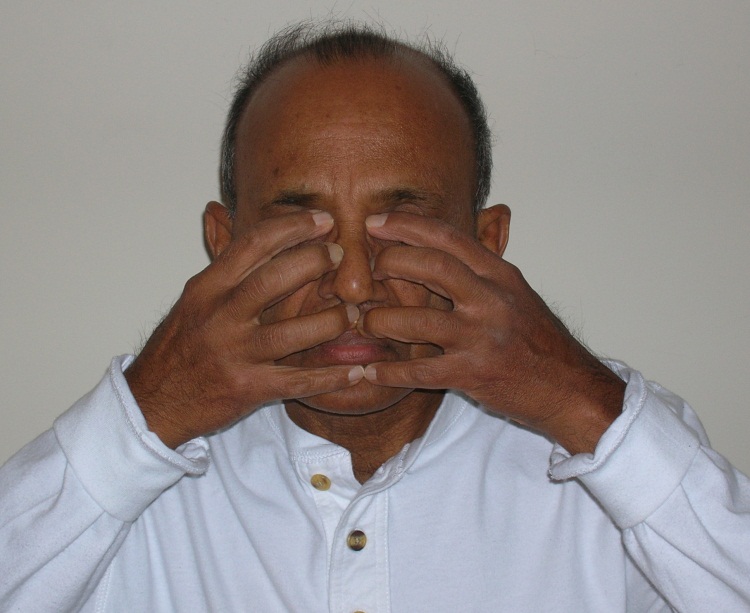
Shanmukhi Mudra
The word ‘bhramari’ (भ्रामरी) refers to the humming sound made by a ‘bhramara’ (a bumble bee in Sanskrit). The Bhramari Pranayama consists in making a deep, soft humming bee-like sound while inhaling and exhaling.
Because Bhramari Pranayama has a very calming effect on the nerves and the mind, it is usually practiced as a prelude to meditation. As a part of the pranayama routine, it should be practiced at the end of other pranayama practices, usually after the alternate nostril breathing (naadi shuddhi, aka Anuloma Viloma), prior to getting ready for meditation.
Bhramari Pranayama is also practiced as a part of the yoga tradition called Nada Yoga (yoga of sound). As the name implies, Nada Yoga uses the element of sound, both external and internal, to reach higher levels of consciousness. In the subtle stage of Nada Yoga, one listens to internal sounds allowing the perceived sound to arise spontaneously. The Bhramari Pranayama is used as a preliminary stage of the practice of Nada Yoga.
Shanmukhi mudra
Bhramari Pranayama is commonly practiced while applying the Shanmukhi Mudra (also known as Yoni Mudra). The word ‘shanmukhi’ (शन्मुखी) is composed of two Sanskrit words – ‘shat’ (six) and ‘mukhi’ (mouths or gates). So the full name means the ‘six-gated mudra (gesture)’. The six gates refer to the two eyes, two ears, nose and the mouth. The purpose of the Shanmukhi Mudra is to symbolically shut the mind from the five senses so the mind can maintain an inward focus in the state of pratyahara (sense withdrawal) and get ready for meditation.
To shut the senses, the thumbs are used to plug the ears, the index fingers are placed on the eyelids, the middle fingers on the two nostrils, the ring fingers above the upper lip and the little fingers under the lower lip. There is no effort to press tightly against these organs but a light pressure is applied with the thumbs and fingers.
Here is how Bhramari is described in the Hatha Yoga Pradipika, the guiding text for most yoga practices:
"While breathing in, make a reverberating sound like the male humming bee, and while exhaling slowly, softly make the sound of the female bee. By this yogic practice one becomes lord of the yogis and the mind is absorbed in bliss." (chapter 2, verse 68)
Even though the above verse states that the humming sound should be made both during inhalation and exhalation, Bhramari is commonly practiced with the humming sound during exhalation only. This is primarily because making the humming sound during inhalation requires more effort and practice.
In the video presented here, I have demonstrated the humming sound both during inhalation and exhalation. I hope you enjoy praciticing with the video.
Step-by-step
Humming during exhalation only
- Sit in any comfortable, cross-legged meditation posture with the spine upright, arms and shoulders relaxed.
- Apply the Shanmukhi Mudra as explained above. Apply light pressure with the thumbs and the fingers against the various sense organs.
- Fix your mental focus at the third eye (Ajna Chakra), the spot between the eyebrows.
- Take a deep inhalation
- While exhaling, make a soft, humming sound. Try to keep the breathing deep and gentle so as to maximize the duration of exhalation without straining the breathing in any way.
- Repeat the cycle of inhalation followed by the humming exhalation six to eight times.
- At the end of the routine, you may continue with your own silent meditation.
Humming during inhalation and exhalation
- Sit in any comfortable, cross-legged meditation posture with the spine upright, arms and shoulders relaxed.
- Apply the Shanmukhi Mudra as explained above. Apply light pressure with the thumbs and the fingers against the various sense organs.
- Fix your mental focus at the third eye (Ajna Chakra), the spot between the eyebrows
- While inhaling, constricting the passage of air at the back of the upper palate, make a soothing, humming sound. At the end of inhalation, after a brief pause, begin the exhalation making the regular humming sound.
- Repeat the above cycle six to eight times.
- At the end of the routine, you may continue with your own silent meditation.
Benefits
- Bhramari causes the whole brain to vibrate. Vibration of the cerebral cortex sends impulses to the hypothalamus which has the capacity to control the pituitary gland- the master of all glands. The hypothalamus also sends impulses to the sympathetic and parasympathetic nervous systems. This helps tune the whole neuro-endocrinal system to function in a harmonious and synchronized way.
- It calms the nervous system and brings in a mental state of calm and peace which is helpful in meditation.
- It helps in conditions of mental tension, high blood pressure, anxiety and heart-related problems.
- By constant practice of Bhramari, the yogi’s mind is absorbed in bliss (Hatha Yoga Pradipika -2.68)
- Here is an excerpt from an article that I came across recently. This article talks about the benefits of Bhramari for pregnant women based on research findings on several participants. The same benefits are applicable to all who practice this pranayama technique.
"… bhramari done for a few minutes daily can alleviate anxiety and tension. Vibration of the brain sends impulses to the reticular formation which eliminates anxiety and improves the mood, behavior and personality, so that the expectant mother may take care of her health and nutrition, leading to proper growth and development of the fetus. During labor, elimination of anxiety makes the mother co-operative and less apprehensive, thus facilitating easy delivery. " You can read the full article here.
Contraindications
There are no contraindications for this practice. Anyone who can breathe can practice Bhramari for great benefits.
Recent Comments